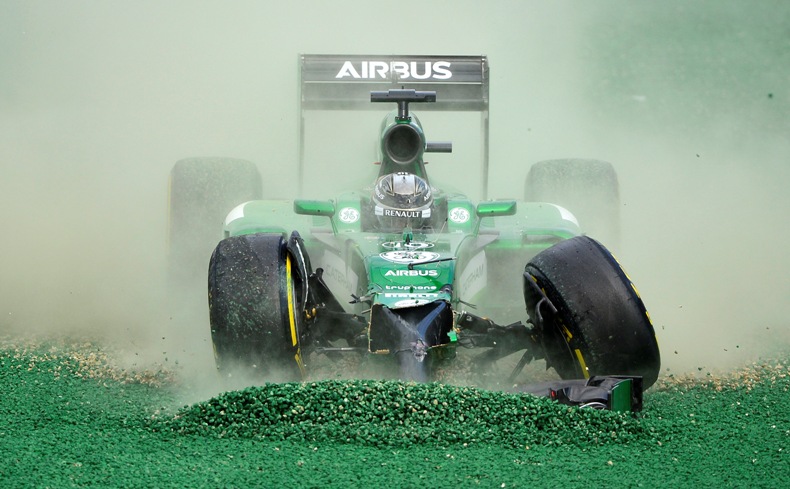In case you couldn’t hear it, Formula One’s new era began in Melbourne on Sunday with Nico Rosberg recording Mercedes’ 100th Grand Prix victory as an engine manufacturer.
The major talking point of the weekend, inevitably, was the new rules, particularly the introduction of the still rather fragile, highly expensive, highly efficient power units and other complex components. These rules, which have perplexed many of the teams throughout winter testing, are designed at least in part to more closely link Formula One with road car technology, with the aim of increasing manufacturer involvement – Honda would not be returning to the sport next year had the old V8 era continued. But while fears that unreliability would decimate the field were unfounded – 14 cars crossed the line after 57 racing laps – the much deeper, much quieter sound has divided fans of the sport.
On the ground reports in Melbourne suggested that the television coverage broadcast to the world did not do the new engines justice, but the sound drew fury from the Australian Grand Prix Corporation which organises, rather superbly, the season-opening race. Speaking to Fairfax radio on Monday, AGPC chief executive Andrew Westacott delivered this appraisal. “One aspect of it [the sound] was just a little bit duller than it’s ever been before and that’s part of the mix and the chemistry that they’re going to have to get right,” he said, before revealing AGPC chairman Ron Walker phoned Bernie Ecclestone, who did not travel to Melbourne after the race to say “‘the fans don’t like it in the venue’”. Westacott added: “We pay for a product, we’ve got contracts in place, we are looking at those very, very seriously because we reckon there has probably been some breaches.” Quite what those breaches might be remained unsaid, but the organisers’ complaints are likely to fall on, ahem, deaf ears.
Albert Park life
All the indications are that a deal appears to be on the table for Melbourne to continue hosting the Australian Grand Prix beyond 2015. Next year’s race is the final event covered by the existing deal, which was negotiated in 2008, but a renewal now seems all but certain, although approval is required by the Victorian state government, whose contribution to staging the event in Albert Park is always subject to intense scrutiny and debate. Attendance figures for this year, meanwhile, were slightly down on 2013, according to the local Melbourne Herald Sun newspaper. The four-day event, which as usual included a full programme of support races, notably the V8 Supercars, attracted 314,900 compared with 323,300 in 2012. Race day attendance was pegged at 100,500, compared to 103,000 last year.

Alonso tops the table
The class of 2014 posed for the annual driver photo on the grid in Melbourne on Sunday morning, full of high hopes – optimism which, in some cases, proved misguided from the moments the lights went out at 5pm local time. This year’s crop features three newcomers – Dane Kevin Magnussen, Russia’s Daniil Kyvat and Swede Marcus Ericsson – but it was one of the five world champions in the field who was ranked as the most marketable of the 22 in the lead-up to the first race of the year. Double world champion Fernando Alonso, who has finished second in the title race in three of the past four seasons, came out on top in a study conducted by global research specialists Repucom, via its Celebrity DBI service. Alonso is, the study said, known by 71.14 per cent of people around the world and 98.35 per cent of Spaniards. Mercedes’ Lewis Hamilton was second in the list, known around the world by 63.65 per cent ahead of former Ferrari driver Felipe Massa (60.98 per cent), who is driving for Williams this year. World champion Sebastian Vettel (54.3 per cent) and returning Ferrari driver Kimi Raikkonen (59.98 per cent) completed the top five.
Movement at McLaren
McLaren still don’t have a replacement for the departed Vodafone as title sponsor, although the returning Ron Dennis and new racing director Eric Boullier both insist one is on the way. Rather than race the rather sparse-looking livery which ran in testing, McLaren chose to highlight the 20th anniversary of its partnership with Mobil 1, a company which contributes around US$35 million to the team annually as well as supplying fuel and technical support. On a weekend when the team scored its first podium finish since 2012, a return to form which puts it at the top of the constructors’ championship, McLaren also ran with the logos of online retailer Asos.com adorning its rear wing, although strangely no press release or formal announcement was made confirming the agreement.
Quote of the weekend
“This victory has a very special meaning for us, too. I would like to dedicate it to Michael, who has been in all our thoughts this weekend. He will keep fighting as only he knows how, and we are sending all our strength to him today”.
Mercedes motorsport chief Toto Wolff, no doubt echoing the views of everyone in the paddock, dedicates victory to Michael Schumacher, who remains in hospital in Grenoble following his skiing accident in December.

